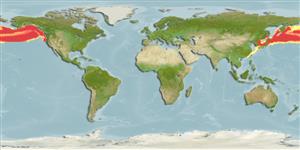Classification / Names
Nomi Comuni | Sinonimi | Catalog of Fishes(Genere, Specie) | ITIS | CoL | WoRMS | Cloffa
>
Aulopiformes (Grinners) >
Notosudidae (Waryfishes)
Etymology: Scopelosaurus: Greek, skopelos = a lantern fish + Greek, sauros = lizard (Ref. 45335).
Environment: milieu / climate zone / depth range / distribution range
Ecologia
marino batipelagico; distribuzione batimetrica 102 - 1440 m (Ref. 50550). Deep-water; 60°N - 20°N
North Pacific: off Taiwan, waters of Kamchatka, Japan, and Kuril Islands, Sea of Okhotsk, Bering Sea, off British Columbia, California and Alaska Bay.
Size / Peso / Age
Maturity: Lm ? range ? - ? cm
Max length : 31.0 cm SL maschio/sesso non determinato; (Ref. )
Short description
Morfologia | Morfometria
Spine dorsali (totale): 0; Raggi dorsali molli (totale): 10-11; Spine anali 0; Raggi anali molli: 17 - 20; Vertebre: 58 - 61. Pyloric caeca, 16-26.
Individuals of 20-22 cm SL, feeds on various types of plankton, almost exclusively deep-sea copepods of Pareuchaeta. Larger specimens also feed on squid, shrimp, and fish (Ref. 35945).
Life cycle and mating behavior
Maturità | Riproduzione | Deposizione | Uova | Fecundity | Larve
Balanov, A.A. and V.F. Savinykh, 1999. Redescriptions of Scopelosaurus harryi and S. adleri (Notosudidae): two valid mesopelagic species inhabiting the northern part of the Pacific Ocean. J. Ichthyol. 39(8):616-625. (Ref. 35945)
IUCN Red List Status (Ref. 130435)
Threat to humans
Harmless
Human uses
Informazioni ulteriori
Nomi ComuniSinonimiMetabolismoPredatoriEcotossicologiaRiproduzioneMaturitàDeposizioneSpawning aggregationFecundityUovaEgg development
Age/SizeAccrescimentoLength-weightLength-lengthLength-frequenciesMorfometriaMorfologiaLarveDinamica popolazioni larvaliReclutamentoAbbondanzaBRUVS
BibliografiaAcquacolturaProfilo di acquacolturaVarietàGeneticaElectrophoresesEreditarietàMalattieElaborazioneNutrientsMass conversion
CollaboratoriImmaginiStamps, Coins Misc.SuoniCiguateraVelocitàModalità di nuotoArea branchialeOtolithsCervelliVista
Strumenti
Special reports
Download XML
Fonti Internet
Estimates based on models
Preferred temperature (Ref.
123201): 0.3 - 5.7, mean 3.4 °C (based on 98 cells).
Phylogenetic diversity index (Ref.
82804): PD
50 = 0.5001 [Uniqueness, from 0.5 = low to 2.0 = high].
Bayesian length-weight: a=0.00288 (0.00120 - 0.00692), b=3.18 (2.96 - 3.40), in cm total length, based on LWR estimates for this (Sub)family-body shape (Ref.
93245).
Trophic level (Ref.
69278): 4.5 ±0.0 se; based on diet studies.
Fishing Vulnerability (Ref.
59153): Low to moderate vulnerability (28 of 100).
